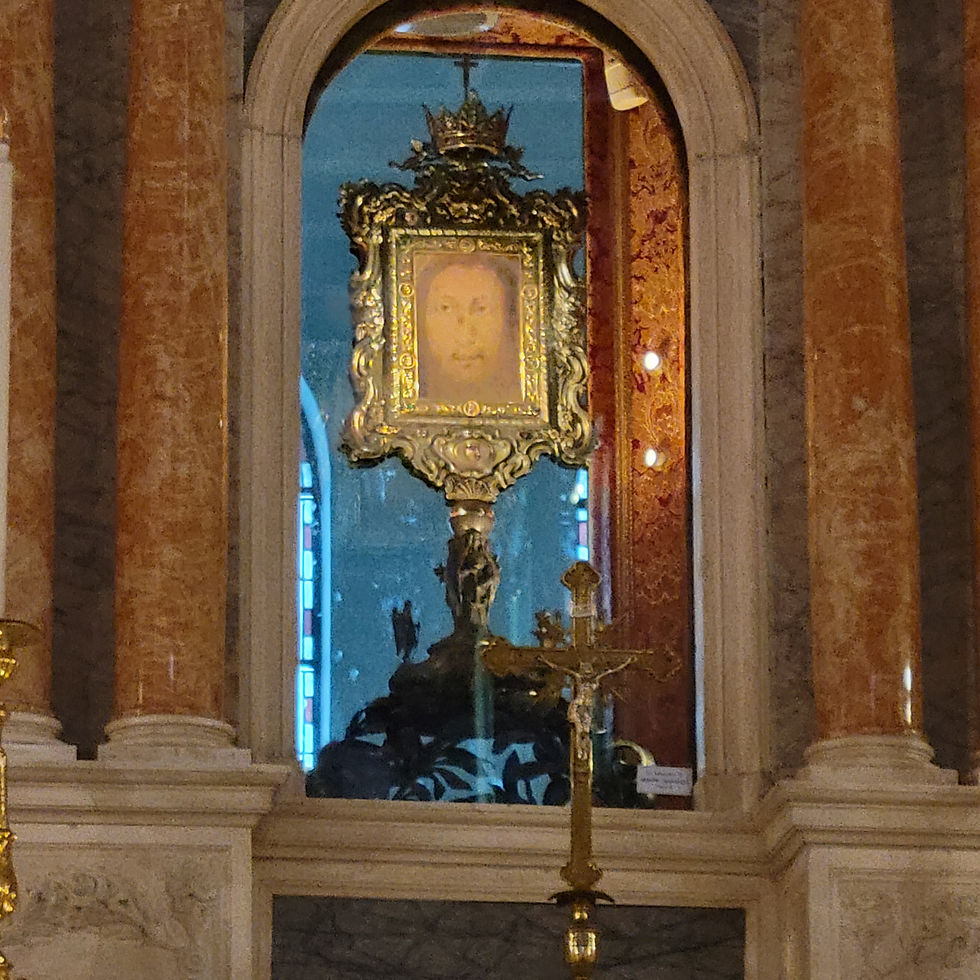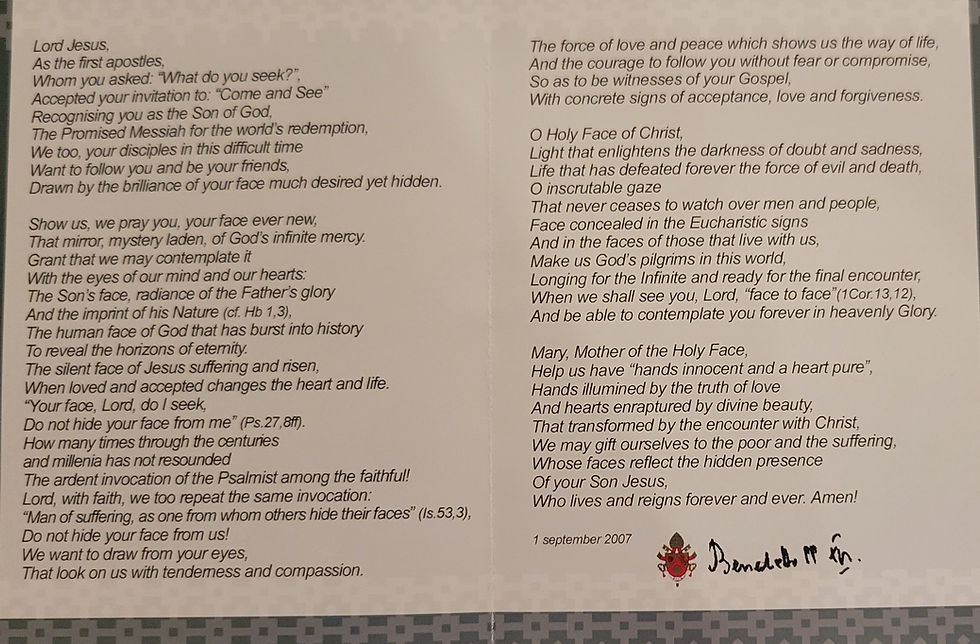NETFLIX AND THE VOLTO SANTO - PART 2 - THE TRUTH.
- padredomenicovolto
- Nov 15, 2023
- 4 min read

Due to recent comments that I have received, I decided to watch this Netflix series, watching the related programming to the Volto Santo, the precious relic of our Lord's Resurrected Face kept in the Basilica of the Volto Santo in Manoppello, Italy since 1638. While I am also personally very much aware of the relics related to our Lord, Jesus Christ's passion in the Basilica di Santa Croce in Gerusalemme, in Rome, Italy; this article is specific to only the statements from this "documentary" regarding the Volto Santo.
First, I would like to address the comments made by Roberto Falcinelli. During the Netflix program, Mr. Falcinelli was referred to as an "Art Historian", in fact, he is actually not an art historian but that of a photographer confirmed to me by Antonio Bini.

Pictures taken from the Netflix series by Liz Dempsey.
I would also like to share a link given to me by Antonio, a renowned journalist in the Abruzzo region of Italy, who actually knows Roberto Falcinelli personally, which describes the Volto Santo.
Santuario del Volto Santo website, under Menu - "Natural colors in the Holy Face, an artist's work?" This article will give the reader much more information, www.voltosanto.it

This is an image displayed as a photograph of the marine byssus which is the material that the Volto Santo is made from, during the Netflix series, stating that the Volto Santo was "painted" by Mr. Falcinelli.
Chiara Vigo, a 24th generation Master Weaver of marine byssus from Sardenia, has confirmed the material used to weave the Volto Santo, which is in fact that from the Pinna Nobilis Mollusk. This fiber due to its substance is impossible to paint. Byssus is very delicate, and can not retain any pigments, it can only be dyed. The fibers once woven can last for thousands of years. According to Chiara, in an article she had reported that Princess Berenice, the great-grandaughter of Herod the Great, during the second half of the first century had brought the art of weaving byssus to Sant'Antioco.

In this photograph, again taken by Liz during the Netflix series by Mr. Falcinelli, you can clearly see when the Volto Santo is exposed to light, the golden threads can be seen, hence the name, "Gold of the Sea". This precious and costly fabric was mentioned throughout the Bible.
Now, that the material of the Volto Santo has been explained, let us not forget that this image was studied using the "Wood's Lamp" examination in 1974, which emits an ultraviolet light which could detect the presence of color. Not to mention in 1998-1999, Professor Donato Vittore at the University of Bari conducted extensive research on the Volto Santo which confirmed that this could not be painted. So why was none of this information presented during the Netflix series? Again, my question is, if Mr. Falcinelli is stating this image had been painted, "What kind of paint could be used that would not show up between fibers?" Oil is a thick paint, watercolor could not be so precise. Also, what brush then could be used to paint a fiber the thickness of a human hair? Or more precisely, due to the microstructure which has a similarity of a liquid crystal matrices. Total reflection can occur, yet none of this was mentioned.

How can someone "paint" the eyes of our Lord looking in 2 different directions on a fabric the thickness of a human hair?

Now, why were no photographs of all the ex-votos ever shown during this program? If one goes up the stairs to the upper level in the Basilica of the Volto Santo, you can see hundreds of items given in thanksgiving, lining the walls including crutches/braces, etc. Below are only a few pictures that I had taken.
Interesting note, Paul Badde, Sr. Petra-Maria Steiner nor Sr. Blandina Paschalis Schlomer were ever interviewed for this series as experts on this precious relic. Many of you may know Paul for having written several books on the Volto Santo, he is a journalist and correspondent for EWTN who now lives in Rome. Sr. Petra-Maria has also written books, was the sacristan, and guided pilgrims at the Basilica of the Volto Santo for many years. Sr. Blandina is an iconographer and lives on Via Padre Domenico da Cese, known as the "First Apostle of the Holy Face". Padre Domenico arranged an exhibit on the Volto Santo for the National Eucharistic Congress in Pescara in September 1977, in which Pope Paul VI attended.




Now for the second part, that of the comments made by Netflix, regarding Pope Benedict XVI. Stating he did not give any acknowledgement of the authenticity of the Volto Santo.

Pope Benedict XVI pictured with Archbishop Bruno Forte (Diocese of Chieti-Vasto) before the Volto Santo during his visit on September 1, 2006. These pictures of Pope Benedict are taken from the book entitled, "Il Volto Santo di Manoppello Il Pellegrinaggio di S.S. Benedetto XVI 1 Settembre 2006".

A handwritten note by Pope Benedict XVI to the Capuchins at the Basilica of the Volto Santo which translates as: "May the Lord help you to know His Face more and more and to see the Father in this way! In communion of prayer in the common search for His Face.".

Padre Carmine Cucinelli pictured with Pope Benedict XVI.

After the visit of Pope Benedict XVI, on September 22, 2006, Pope Benedict XVI raised the Sanctuary of the Volto Santo to that of a Minor Basilica. Then on September 1, 2007, sent a prayer in honor of the Volto Santo to the then Rector at the Basilica of the Volto Santo to Padre Carmen Cucinelli.

All of these factual points of reference were absent from this Netflix series. While the program showcased the image of our Lord in the Volto Santo, which in itself was a good thing, the comments to persuade viewers away from the truth can not be ignored. Please share this article with as many people that you may know, so that they themselves can know the truth.

Padre Antonio Gentili, the current Rector at the Basilica of the Volto Santo, may our Lord bless him always.
Grazie mille to Padre Gentili and Padre Cucinelli!!!
Uniti in preghiere, Tamara Klapatch



This happens often when programs CLAIM to give the truth about special items, instances or people related to the Roman Catholic Church. Many who do not know the Catholic Faith and the Church, go away thinking that we are a cult, and a stupid and evil one at that. Many channels carry this kind of programming. Sadly, most people only know the hype, the rumors, the conspiracy theories. They don't take the time to research and dig deep to find the truth.